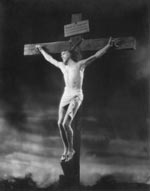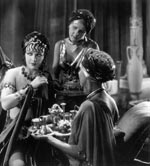The success of Mel Gibson’s The Passion of The Christ has brought renewed attention to the old biblical epics, and if there is any one film that shares Gibson’s visual sensibility and his pious but sometimes lurid flair for melodrama, it would have to be Cecil B. DeMille’s The King of Kings, new on DVD today as the latest classic release from Criterion Collection. Both films feature a hedonistic banquet populated by laughing revelers and a leopard on a leash. Both films feature a crow perched on a thief’s cross. And both films feature fantastic earthquake sequences after Jesus dies—though no one can match DeMille, who seems to think he’s making another Moses movie, for sheer over-the-topness.
The King of Kings was first released in the spring of 1927, and it was the middle chapter in a sort of informal biblical trilogy that DeMille produced, beginning with the original, silent version of The Ten Commandments (1923) and ending with the early talkie The Sign of the Cross (1932), which depicts Nero’s persecution of the early Christians. Despite being a silent film itself, The King of Kings remained popular well into the sound era, so much so that no other major Hollywood movie about the life of Christ was made for over 30 years, until Nicholas Ray directed the similarly-titled King of Kings in 1961.
DeMille, working from a script by Jeanie Macpherson, rearranges episodes from the Gospels in ways that are startlingly original yet quite effective. The film begins when Jesus (H. B. Warner) has already embarked on his ministry, so it does not depict his birth or his baptism by his cousin John—but it does depict Satan’s temptation of him, by setting it in the Temple after Jesus has kicked out the money changers. As the crowds praise Jesus and hail him as their king, Satan (Alan Brooks) offers him the kingdoms of the world; and while this clearly isn’t quite how the Gospels describe these events, the combined sequences do heighten our awareness of the earthly power Christ could have claimed for himself, but did not.

Alas, The King of Kings also reflects DeMille’s belief that you needed to promise audiences a bit of sin in order to lure them into the theatre, so long as you punished or redeemed the sinners and thus satisfied the more religious members of your audience; he made his films for flappers and fundamentalists alike. Thus he begins the film on a rather ludicrous note, with a lavish party hosted by a scantily-clad Mary Magdalene (Jacqueline Logan), who is depicted here not only as a prostitute—a western tradition for which there is no biblical warrant—but as a seducer of kings who burns with jealousy when she hears that her lover, Judas Iscariot (Joseph Schildkraut), now follows the carpenter from Nazareth.
Fortunately, DeMille drops this ersatz love triangle relatively quickly, and the rest of the film proceeds quite reverently. While there is no basis for the tradition that Mary was a harlot, the Bible does tell us that Jesus cleansed her of seven demons (Luke 8:2), and DeMille, to his credit, is one of the few filmmakers to depict this. When she arrives in her chariot—pulled by five plumed zebras!—and demands to see this healer for herself, Jesus promptly casts the Seven Deadly Sins out of her, in a series of multiple-exposure shots that are impressive even by today’s standards. In this as in other things, DeMille was all in favor of biblical authenticity if it meant another eye-opening, jaw-dropping special effect.
Some aspects of the film seem more dated now. H. B. Warner’s performance as Jesus has its merits, but lends itself all too well to the wimpy “meek and mild” image that more recent filmmakers have tried to undo. In addition, Warner was 51 when the film came out, and must rank as one of the oldest actors to have ever played the Savior onscreen; presumably his age was meant to communicate Jesus’ wisdom and authority. In contrast, the Virgin Mary is played by Dorothy Cumming, who was only 28; presumably her youth, and her nun-like attire, were meant as a nod to Catholic beliefs about Mary’s incorruptibility.

It is also striking to see how DeMille—who solicited the endorsements of not only Catholics and Protestants, but also Jews, Muslims, Buddhists and Christian Scientists—tweaks the story to avoid accusations of anti-Semitism. An opening title card informs us that Jews in the first century were “under the complete subjection of Rome,” and their high priest, Caiaphas (Rudolph Schildkraut), was appointed by the Roman procurator, Pontius Pilate (Victor Varconi). Later, when Caiaphas bribes a crowd to call for the death of Jesus, DeMille adapts and revises Matthew 27:25 so that Caiaphas declares, “If thou, imperial Pilate, wouldst wash thy hands of this Man’s death, let it be upon me—and me alone!” In this scene, DeMille explicitly lays the blame for Jesus’ death on a single man, and not, as some people have interpreted that controversial passage, on the Jews as a whole.
The King of Kings was released just a few months before The Jazz Singer revolutionized the use of sound in motion pictures, so in the years that followed, DeMille reissued his film, cutting it down to just under two hours and giving it a permanent soundtrack featuring an orchestral score by Hugo Riesenfeld and just a few sound effects. For years, this edited version of the film was pretty much the only one you could see. But now, the Criterion label—which specializes in restoring films of historical significance—has made both the edited version and the longer, 155-minute “roadshow” version available in a two-disc set. (For more about the two versions, click here.)
And for those familiar only with the shorter version of the film, the original, longer version is a revelation. Most significantly, it enhances the role of Judas, and his efforts to exploit the ministry of Christ for political purposes. The original film also suggests it was Judas who tried to cast a demon out of a possessed boy but failed, presumably because he wasn’t a “real” disciple, before Jesus came along and did the job properly ( Mark 9:14-29).
Other roles are enhanced, too. The Virgin Mary comforts the mother of one of the thieves at Calvary, and can now be seen directing Jesus’s attention to Mary Magdalene outside the empty tomb; Pilate’s wife (Majel Coleman) makes an appearance; and the scene in which Peter (Ernest Torrence) denies Christ has been fully restored. In keeping with DeMille’s creative rearranging of biblical stories, the longer film also includes a sequence that brilliantly combines the conversion of the tax collector Matthew (Mark 2:14), the exchange in which Jesus advocates paying taxes to Caesar (Mark 12:13-17), and the episode in which Jesus pays the Temple tax with a coin that Peter finds inside the mouth of a fish (Matthew 17:24-27). DeMille plays this last bit for laughs, as two soldiers go fishing in search of even more money; one shakes a fish next to his ear, hoping to hear some loose change.
Not all the enhancements are positive. In the shorter version, everything is black-and-white until the Resurrection, which is shown in full two-strip Technicolor; but the longer version shows Mary Magdalene’s opening banquet in Technicolor, too, which unfortunately puts this utterly bogus sequence on the same visually impressive level as Easter Sunday. Still, in nearly every other way, the “roadshow” version is a vast improvement.
The Criterion DVD includes a number of other goodies in addition to the films themselves. The shorter version of the film has an alternate audio track featuring brand-new pipe-organ music by Timothy J. Tikker, similar to what many silent films have when released on video, and the longer version has a brand-new orchestra-and-synthesizer score by Donald Sosin, too; it is interesting to see which score uses which hymns, and when.
The set also includes essays, publicity stills (including one of DeMille and six bankers posing with an actor dressed as a money changer!), footage of silent-era superstars D.W. Griffith and Douglas Fairbanks visiting the set, and the original theatrical trailers, one of which says the film’s “scenes of magnificence, tragedy, triumph, hurricanes, earthquakes and great mobs in panic are attracting crowds of every age, taste and inclination.”
Some of us might hope the gospel was part of the appeal, too!
Talk About It
Discussion starters- What do you make of the way the film rearranges the biblical material? Does seeing the stories in new forms open up meanings you hadn’t noticed before? Or does it obscure the meaning of the original Scriptures? Does it do both at the same time? Can this be compared, perhaps, to how the Gospels sometimes arrange episodes from Jesus’ life in different ways? Explain.
- What are the pros and cons of telling the gospel story through the “popular” media? Can the story of Jesus ever be told in a way that will appeal to a wide audience? Or is it more important to get the story told, period, and to leave the fine-tuning to the churches?
- Does anything in this film—such as the opening banquet, or the climactic earthquake, perhaps—seem like it was put there “just because it’s a movie”? What stands out most when you watch the film, the spectacle or the message? Does the spectacle ever enhance the message? Does it get in the way? Point to specific scenes.
- What do you think of this film’s portrayal of Jesus? Is he too divine? Not divine enough? Too human? Not human enough? Do you think this film gave audiences back then the Jesus that they wanted, or do you think it challenged their ideas about Jesus? How does seeing the portrayals of Jesus from an earlier era challenge our own ideas?
The Family Corner
For parents to considerThe King of Kings is not rated. Violent content is limited to scenes of flogging and crucifixion that are standard for biblical films of this sort. Sexual content is limited to the opening scenes, in which Mary Magdalene wears very suggestive clothing. The film includes several scenes that will appeal especially to children: the future evangelist Mark is depicted here as a young boy who is cured of lameness, and the first time we see Jesus’ face, it is through the eyes of a blind girl as her sight is restored; there is also an amusing scene in which a child asks Jesus if, being healer and carpenter, he can mend her doll’s broken leg.
Copyright © 2004 Christianity Today. Click for reprint information.










